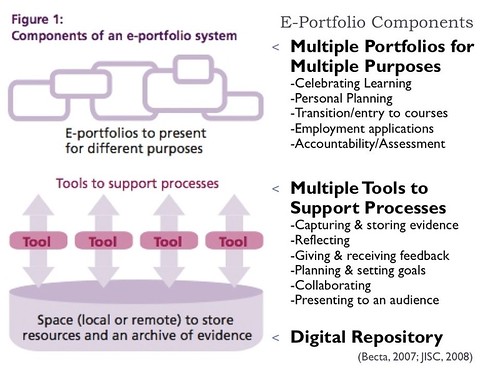This morning, I read the following tweet:
Had a student bring an iPad with his digital portfolio to an interview. Keynote with pictures and video of him teaching. Cool! (@alvintrusty)
Since I bought Keynote for my iPad, I decided to give it a try. This is now the 37th version of
my online presentation portfolio, but the first developed using my iPad. I found the
2007 version of my portfolio that I created in PowerPoint, and imported it into Keynote on my Mac (I found out later it was an unnecessary step... Keynote on the iPad will convert PowerPoint files). Then, I connected my iPad to my laptop and through iTunes, imported the file into my iPad. Once transferred to my iPad, I was able to activate
iWork.com through my Apple account and upload the keynote file to that website. Once there, I activated public sharing and received
the link to share it publically (I was able to update the file the next day, but needed to make the link public again on the iWork website). I noticed that embedded hyperlinks worked on the iPad, but not on the iWork.com website.
In the original Powerpoint, I used the Speakers Notes to record my reflections. When the file was imported into the iPad, the notes were stripped out. Interesting! It really didn't take me long to do this conversion with a few simple edits. The iWork website has a place to add notes, so there is a level of interactivity once it is uploaded. This was the first presentation that I edited on the iPad. It looks pretty easy to use. I would prefer a more interactive environment for a working portfolio, but this format is more appropriate for a presentation portfolio, and iWork.com appears to be free when used with the Mac or iPad version of the iWork software.
I placed weblinks in the original Powerpoint, and they appeared in the iPad version. The links worked in presentation mode, but to get back into my presentation, I needed to open Keynote again... and I was not connected to a projector, so I don't know if the web pages would show through the projector. I did notice that the .mov videos that were stored on my .Mac account did not play in Safari on the iPad. Next time, I will see about embedding videos in my next Keynote presentation, to see how it works. I haven't yet figured out whether videos imported into the iPad through iTunes can be linked to play from within Keynote.
This ePortfolio can be viewed either online or on the iPad without Internet access. The real downside of this process is versioning: if I make changes on my iPad, I need to be careful if I transfer it back to my Mac, to make sure I am saving the most recent version... and I would need to upload the changed version to iWork.com, which replaces the older version (but eliminates the public link, which needs to be reset on the iWork website). This illustrates the value of editing my
GoogleDocs Presentation version: the latest version is always stored online. (However, right now I cannot edit GoogleDocs through the iPad's Safari browser.)
I am looking forward to future developments in the software for this platform. I have used Keynote to create a presentation portfolio and shared it using my iPad; there are blogging tools for maintaining a working/reflecting portfolio (WordPress and BlogPress on the iPad); and I can store files in many cloud storage sites, including GoogleDocs,
box.net, Apple's iDisk or
mydisk.se. These are all three main components of a learner-centered portfolio system: storage of artifacts, reflection/documenting learning over time, and a presentation/showcase medium. We just need
a tool to tie them all together. I am anxious to see how this environment matures, and how easily it can be implemented by learners of different ages!
![Reblog this post [with Zemanta]](http://img.zemanta.com/reblog_e.png?x-id=e4f4d4b5-ab73-4903-b278-d13a71b523af)
![Reblog this post [with Zemanta]](http://img.zemanta.com/reblog_e.png?x-id=c5d53bac-12de-4640-b509-2123f9c2a700)



